In this series, I'll go from start to finish on how to
build a home-theater computer with Raspberry Pi and the OpenELEC XBMC
Operating System. At the end we'll be able to install XBMC plugins to stream
videos, including PBS.
This first article about the hardware needed applies to any Raspberry Pi project, not just a video streaming device.
-
Hardware for a Raspberry Pi PBS Streaming Device
-
Installing software for a Raspberry Pi PBS Streaming Device
Overview
Before we get started, we need to acquire all the needed hardware.
- Raspberry Pi ($35)
Technically, this is just $35, but when I ordered directly from a supplier listed on the official website, it took 8 months for me to get my pi. For the impatient, I have seen it listed on
Amazon with Prime eligible shipping.
- Raspberry Pi Enclosure ($6-$20)
The Raspberry Pi comes as a bare circuit board. Luckily, there are a few vendors who sell plastic cases, including this assortment of Raspberry Pi Enclosures on Amazon.
on Amazon.
- HDMI TV or Monitor ($100+)
Most folks will already have a television or monitor supporting HDMI, which
is part of the allure of a Raspberry Pi. Since it is so small, it can be
yet another device on the TV stand. Ours sits next to our Roku.
 If not, there are many
HDMI-input
monitors that come with integrated speakers
If not, there are many
HDMI-input
monitors that come with integrated speakers to choose from.
to choose from.
-
HDMI Cable
 ($6)
($6)
It's likely you have one of these already, but if not any
HDMI
cable should work fine.
should work fine.
- USB charger (700 mAmp)
The Raspberry Pi runs off USB for its power. Not just any USB charger
will work, though, since the Raspberry Pi is very picky about voltages and
needs something that can supply enough power. I'm using the iPhone
USB charger, but a
Kindle
Fire charger
but a
Kindle
Fire charger should work well, too.
should work well, too.
-
Micro
USB Cable

There is a good chance you have one of these already, especially if you
have an Android device. You may want to pick an
extra one up to have a
dedicated cable for your Raspberry Pi, though.
up to have a
dedicated cable for your Raspberry Pi, though.
-
Wireless
USB Adapter

If you don't want to run an Ethernet cable to your TV stand, get this
Wireless
USB Adapter. This
ASUS
USB-N10
This
ASUS
USB-N10 worked out of the box for me. I didn't need to install
any special drivers.
worked out of the box for me. I didn't need to install
any special drivers.
- Ethernet cable
If one is not going the wireless route, this will be connected to your
Raspberry Pi at all times. Otherwise, it is nice to have this connected
while we are setting up so we don't have to worry about configuring
wireless right away.
- SD card
The Raspberry Pi can be finicky about what SD cards it will accept. I used this
Transcend 16GB SD card without any problems. The
AmazonBasics
without any problems. The
AmazonBasics card should work fine, too.
card should work fine, too.
- SD-card reader
The internal card reader on my MacBook did not work. Instead, I had to buy an external
iogear Memory Card Reader/Writer. Once I got the external reader, I was able to flash the SD card for the Raspberry Pi operating system.
Once I got the external reader, I was able to flash the SD card for the Raspberry Pi operating system.
- USB mouse
Any mouse with a USB cable should do fine.
- USB keyboard
It needs to be a USB keyboard, as there are no old-style keyboard inputs on the Raspberry Pi.
- USB hub ($5)
There are only two USB ports on the Raspberry Pi. To have the mouse, keyboard, and wireless card plugged in you will need a hub. The Raspberry Pi forums say a powered USB hub is required, but I used the
Belkin USB Ultra-Mini Hub that I already had to plug in the mouse and keyboard, and it worked fine.
that I already had to plug in the mouse and keyboard, and it worked fine.
- A computer or laptop (Mac/Windows/Linux)
In order to get the operating system setup for the Raspberry Pi, one will need to flash the SD card from a computer or laptop. I did this from a
MacBook Pro. My instructions in the
software article
will show what I did from my Mac.
My instructions in the
software article
will show what I did from my Mac.
That is quite the shopping list, but it is possible, even likely, that you already have most of these things.
Putting together the enclosure
Once you get your Raspberry Pi and its case, it's time to put it together. I got the case through Allied Electronics, which does not include a hole for the general purpose I/O ports. That's OK, though, since we won't be using them for this project. For future projects, I'll want to get a different case, like the
HungryPi
enclosures , which have a hole to put a ribbon cable connecting to the GPIO ports.
, which have a hole to put a ribbon cable connecting to the GPIO ports.
This is the Raspberry Pi and the Allied Electronics case I bought for it. Look at how tiny it is!
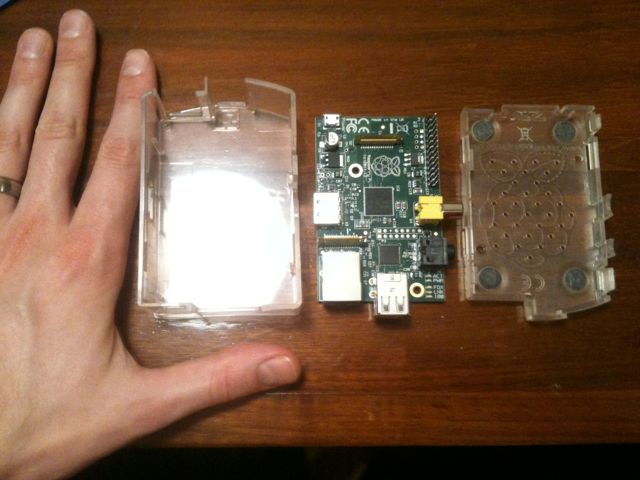
The first step to put it together is to place the Raspberry Pi on the base of the enclosure. Put the left side under the small plastic clips. This leaves the right side (with the GPIO ports) just above the large plastic clips.
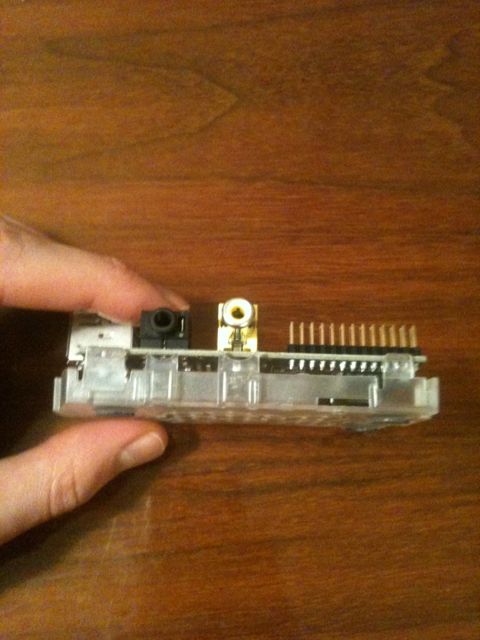
Then, we just clip the board in.
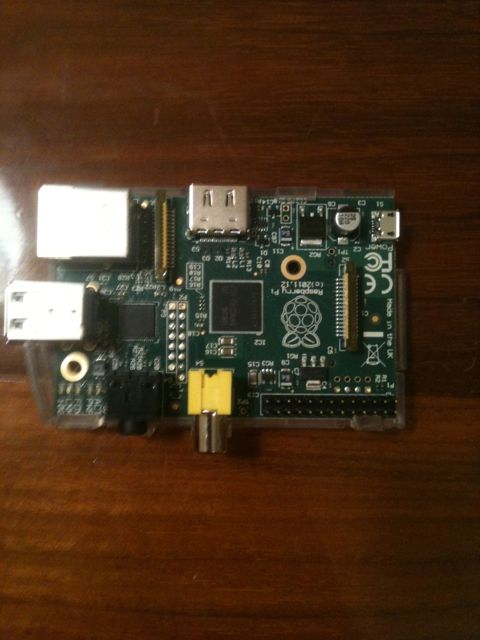
Finally, we put the top part of the enclosure on. Simply line up the slots with the corresponding components and click the top into place.
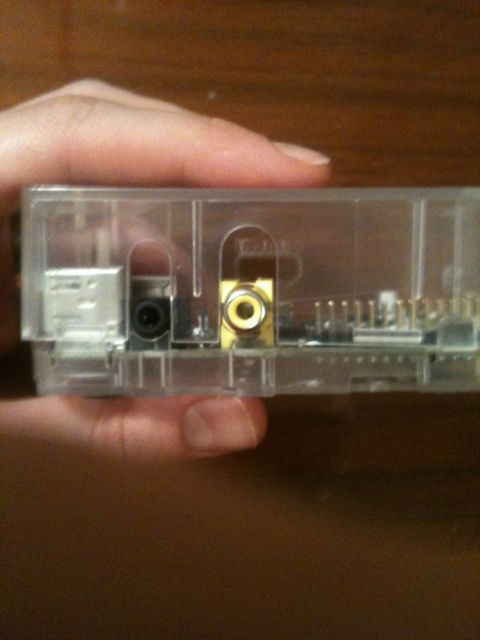
Connecting the components.
Now that the Raspberry Pi is pretty well protected in its enclosure, we can connect the components we will need to it. The two most important things for the Raspberry Pi are the Operating System SD card and the power connection. These are necessary for any Raspberry Pi project, be it a web server, home automation device, or video streaming device.
For building a streaming device, first follow the directions in the software article for flashing the OpenELEC operating system onto the SD card.
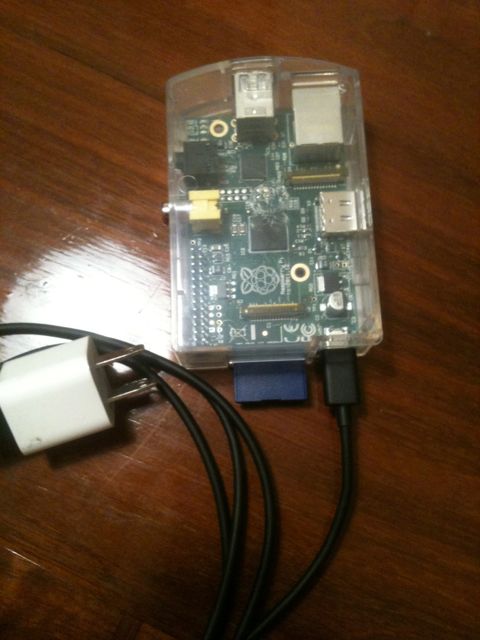
Plug the power cable into the micro-USB port on the Raspberry Pi. The SD card is right next to the micro-USB port. Note that the card needs to go in upside down.

Then, plug in the rest of the devices. This should be pretty straight-forward, since the HDMI and USB ports are well labeled (at least on the case I got).
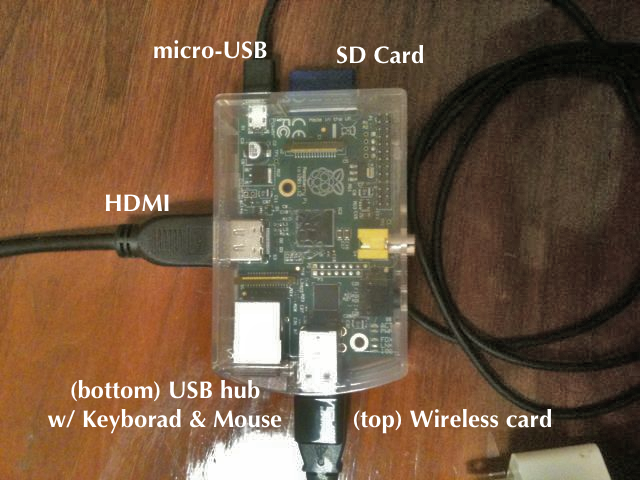
One last thing I have noticed is that for the display to show up, the monitor or TV needs to be on and connected to the HDMI input before plugging the power into the Raspberry Pi.